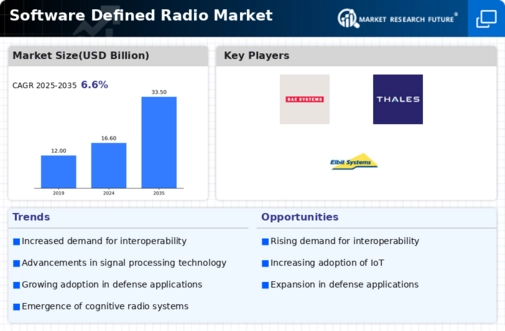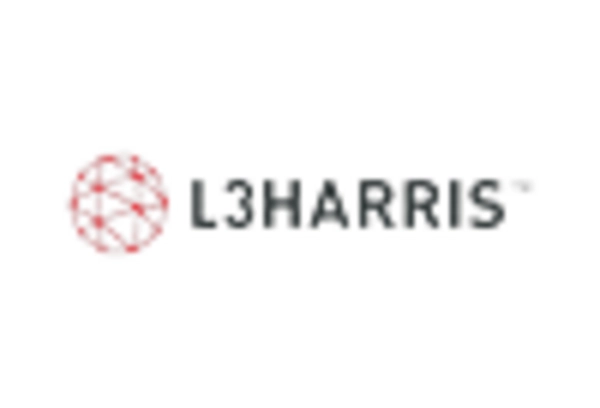Market Analysis
In-depth Analysis of Software Defined Radio Market Industry Landscape
Several market factors contribute to the dynamics of the Software Defined Radio (SDR) market, reflecting the industry's response to technological advancements, regulatory influences, and the diverse demands of end-users. Technological innovation stands out as a primary factor, with continuous advancements in digital signal processing, radio frequency (RF) hardware, and software algorithms enhancing the capabilities of SDR solutions. The ability of SDR to adapt to evolving technologies and standards, such as the transition to 5G and beyond, positions it as a key player in meeting the changing requirements of communication systems.
Buckle up for a software revolution in radio! The software-defined radio (SDR) market, valued at USD 23.72 billion in 2021, is set to blast off at a 10% CAGR by 2030, fueled by a wave of telecom tech advancements. These versatile radios, able to adapt to any frequency on the fly, are already powering vital communication systems for space missions and aerospace ventures, and their impact is set to ripple across industries. So tune in to a future where software tunes the radio, propelling this market to a projected USD 54.3 billion by 2032 – it's time to get signal-locked on the possibilities! Interoperability is a critical market factor shaping the adoption of SDR technologies. With the proliferation of diverse communication standards and protocols, there is a growing need for systems that can seamlessly operate across different frequencies and networks. The flexibility of SDR to accommodate various standards and its ability to promote interoperability make it an attractive solution, especially in applications where cross-platform communication is essential, such as public safety, emergency response, and military operations.
The defense and military sector represents a significant market factor for SDR, driven by the need for agile and adaptable communication systems. The programmable nature of SDR allows military forces to reconfigure communication protocols quickly, respond to dynamic threats, and maintain secure and resilient communication in diverse operational environments. Security considerations, including the ability to implement advanced encryption and secure communication, make SDR a preferred choice for defense applications.
Global demand for advanced wireless communication technologies is a driving factor in the SDR market. As the world embraces the era of 5G and looks ahead to future generations of wireless networks, the need for communication systems that can support higher data rates, lower latency, and improved reliability is paramount. SDR's adaptability to different communication standards positions it as a critical enabler for the evolution of wireless networks, meeting the demands of an increasingly connected world.
Cost-effectiveness is another influential market factor in the adoption of SDR solutions. Traditional radio communication systems often required dedicated hardware for each specific standard, leading to increased costs and complexity. SDR's software-based approach allows for the reuse of existing hardware, reducing the need for frequent hardware upgrades and offering a more cost-effective solution. This factor appeals to industries and organizations seeking efficient ways to upgrade and modernize their communication infrastructure without incurring substantial costs.
Regulatory frameworks and standardization efforts play a crucial role in shaping the SDR market. Adherence to national and international regulations, as well as the establishment of common standards for SDR technologies, contributes to market growth. Standardization fosters interoperability, eases integration challenges, and accelerates the adoption of SDR across different applications and industries. Industry collaboration in defining and adhering to standards is instrumental in shaping the market factors of SDR.
The trend towards software-driven and virtualized network architectures is influencing the SDR market. Telecommunications providers and network operators are increasingly adopting software-centric approaches to manage and control their communication infrastructures. SDR's inherent adaptability to software-defined networking principles positions it as a key technology in the broader shift towards more flexible, scalable, and efficient network architectures.
Security considerations, both in terms of secure communication and resistance to cyber threats, are becoming paramount factors in the adoption of SDR technologies. The programmable nature of SDR allows for the implementation of advanced encryption algorithms and security protocols, making it a preferred choice in applications where data integrity and confidentiality are critical, such as military communication, public safety, and critical infrastructure.
Spectrum efficiency and management are significant factors influencing the adoption of SDR. The growing demand for wireless communication services and the limited availability of spectrum resources necessitate efficient utilization. SDR's dynamic adaptability to spectrum availability, interference avoidance, and optimization of spectrum usage align with the industry's pursuit of effective spectrum management. This factor reflects the industry's focus on addressing the challenges of growing demand for wireless connectivity within the constraints of available spectrum resources.

















Leave a Comment